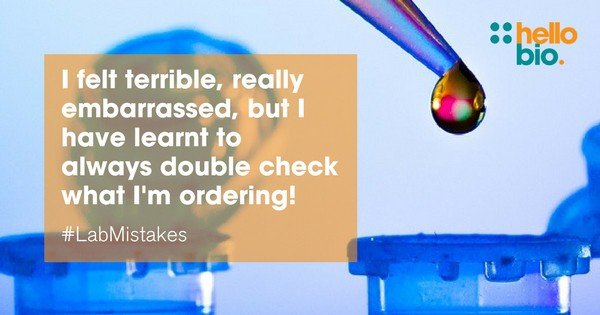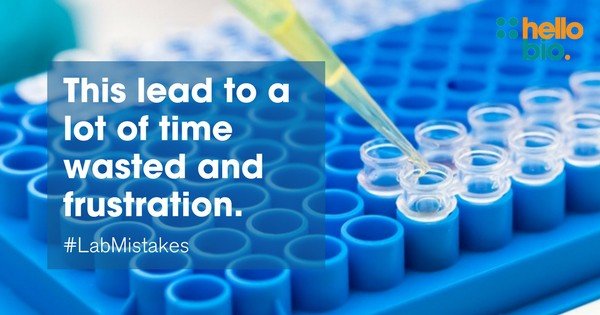Ten common lab mistakes!
We know how difficult it is starting a PhD, or as a post-doc in a new lab. There is much to remember, new protocols, new systems and new techniques to get to grips with. We asked a sample of researchers from a variety of labs - including PhD students, post-docs and lab heads to tell us about their experiences, and the mistakes that are most commonly made.
Lab mistake #1 - Not dissolving your drugs / reagents properly
This mistake came up a lot! Drugs / reagents are not dissolved completely or they may precipitate out in your buffer. This means that you will not be using the drug at the concentration that you think you are! The solution to this is to read your product datasheet carefully, to find out what you have to do – warming or sonicating – but also – don’t forget to use your eyes, and hold your sample up to the light to check that everything has dissolved.
Lab mistake #2 - Ordering the wrong product
There is often a bewildering array of chemical compounds, reagents and variants in supplier catalogs that you need to navigate. From ordering reverse complement primers by mistake, to ordering the wrong enantiomer of a receptor ligand…the consequences of the wrong purchase are obviously the loss of time and money. And, if the mistake isn’t spotted before your experiment begins…see lab mistake #3!
I felt terrible - really embarrassed - but I have learnt to always double check what I am ordering! PhD Student
Lab mistake #3 - Using the wrong reagent in your experiment
Our panel of researchers gave us some real examples – adding b-mercaptoethanol instead of TEMED when preparing a poliacrylamide gel, using the wrong secondary antibody and adding incorrect reagents because they hadn’t read the bottle properly. The consequences of these sorts of mistakes are far reaching – you have to re-run the experiment / technique….The Hello Bio team advice – read labels, check, check and check again!
Lab mistake #4 - Running your electrophoresis backwards!
This one concerns running Western Blots – if you mistakenly invert the connector cables on the power supply and run the electrophoresis backwards – you lose your samples. It’s a mistake that even experienced researchers can make...
...it was very frustrating...I had to repeat an entire experiment that took more than a week to create new samples. Researcher, Post-Doc
Lab mistake #5 - Using the wrong statistical test for your data
Using the wrong statistical analysis on data is a mistake that can cost a lot of time. If you form your conclusions based on an inappropriate analysis of your results – you could end up misinterpreting your data. And the statistical test that your lab colleague uses may not be appropriate for you if your experiment is different. The solution is to decide on your method of analysis at the planning stage – and if you are no statistical expert, make sure you check with a supervisor that you are choosing the right one!
Lab mistake #6 – Losing your peptides!
When you finished freeze drying peptides, make sure you open the vacuum release valve very slowly!
The fruit of my hard work flew all over the place and disappeared right in front of my eyes. Professor, Lab head
Lab mistake #7 - Insufficient centrifuging of samples
Not spinning solubilised samples at high enough speed in an ultracentrifuge before co-immunoprecipitation or GST fusion protein pull-down is a common mistake. If you don’t use a high enough centrifugation force (e.g. 100,000 x g or higher) then non-solubilised membrane components and protein aggregates will remain in the sample. These will be subsequently identified as ‘interaction partners’ in co-immunoprecipitation and GST pull-down experiments. It’s also a good one to watch out for when reading the scientific literature – just check that the methodology used an appropriate centrifuge, and not a low speed (bench top ) one, as these are not suitable for the complete removal of insoluble protein aggregates.
Lab mistake #8 - Poor or mis-labelling of samples
This is an obvious one - if you muddle up your samples – then you have to go back to square one, and start your experiment again. If handwriting labels, make sure they are legible, and if you are using a physical label (rather than writing on your vial) always use a label suitable for your needs ie. does it need to withstand a freezer or water bath. And always be consistent in the way you label things – follow your lab protocols, and there is less room for confusion!
Lab mistake #9 - Not filling your centrifuge tubes up enough
Another centrifuge mistake - forgetting to fill up your ultracentrifuge tubes with liquid. The tubes will collapse at high speed if you leave them half empty.
Lab mistake #10 – Not paying attention to the detail!
With many techniques, the secret to a successful experiment is to consistently and accurately follow a protocol. For example, in the electrophysiology lab, paying attention to solution flow rates, achieving a stable recording base line, and constructing effective stimulating electrodes all contribute to a successful result.
This lead to a lot of time wasted and frustration, particularly during the early days when it was hard to diagnose the problem. PhD Student
It's not easy to admit to mistakes - so thanks to all of our scientists for sharing! Have you ever made any mistakes in the lab? Share in the comments below, on our Facebook Page, or tweet us @hello_bio
---
If you enjoyed this - you may in interested in these resources...
We try to support scientists in any way we can and offer a range of resources - from useful guides on wellbeing, to travel grants, and lab help. And not forgetting some silly science to unwind. Here's a selection of our top picks:
Guides:
- The Life Scientists' Guide to Wellbeing
- The Life Scientists' Guide for New PhD Students
- The Most Common PhD Problems & How to Get Past Them
- View all of our guides
Resources:
- Apply for a Travel Grant: every month we give away $500 to PhD students and Postdocs so that they can attend a scientific conference. Give it a go - it's really easy to apply.
- You can also read advice from other scientists - in our Interviews with Scientists' series, Ten Common Lab Mistakes and numerous articles on using social media, productivity, careers and more!
Helping you in the Lab:
- Molarity Calculator: a quick and easy way to calculate the mass, volume or concentration required for making a solution
- Dilution Calculator: an easy way to work out how to dilute stock solutions of known concentrations
- Mini-reviews, Pathway Posters & Product Guides: a set of technical resources to answer your questions on a wide range of topics and to help you get started quickly
- And - when you get to the stage of planning your experiments, don't forget that we offer a range of agonists, antagonists, inhibitors, activators, antibodies and fluorescent tools at up to half the price of other suppliers (check out our price comparison table to see for yourself!). The range includes:
|
And finally - don't forget to check back in to the Hello Bio Blog - with features from experts, posts on lab support, events, competitions and some fun stuff along the way!
















